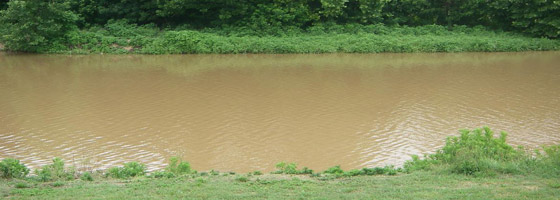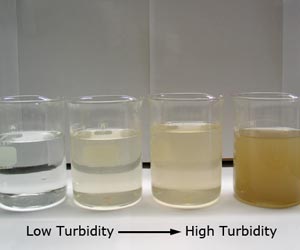Turbidity Measurement

UPDATE: Fondriest Environmental is offering their expertise in turbidity through their new online knowledge base. For an updated and comprehensive look at turbidity, its causes, and its importance, check out: Turbidity, Total Suspended Solids and Water Clarity.
Turbidity is a measurement of the amount of suspended material in the water. It describes the clarity of water. Suspended materials in water, such as clay, silt, and algae, reduce water clarity and cause turbidity.
 Influencing Factors
Influencing Factors
Turbidity increases due to: runoff from construction sites, farm fields, and logging sites; runoff from urban areas with a lot of paved and impermeable surfaces; eroding stream banks; bottom feeding fish and burrowing animals; excessive algae growth; high velocity water, like stormwater; windy conditions in shallow water areas.
A clear mountain stream might have a turbidity of around 1 NTU, whereas a large river like the Mississippi might have a dry-weather turbidity of around 10 NTUs.
The federal standard for high turbidity is 25 NTUs or greater. Turbidity levels are typically less than this, but will show spikes above this level due to factors such as wind, animal feeding, algae growth, and storms. For example, turbidity may jump to hundreds or thousands of NTUs during storm events.
Parameter Importance
Turbidity is an important indicator of the amount of suspended sediment in water, which can have many negative effects on aquatic life. The suspended sediments that cause turbidity can block light to aquatic plants, smother aquatic organisms, and carry contaminants and pathogens, such as lead, mercury, and bacteria.
Long-term turbidity monitoring is very important because it helps us measure the amount of soil erosion due to construction and agriculture, and helps to determine the impact of our land-use practices and increasing urban development on water quality.
How it is Measured
Measuring turbidity is achieved by evaluating the amount of light scattered in water. This can be done with simple visual assessments, such as the original Jackson Candle turbidimeter, or more accurate, technological methods, such as the nephelometric method. Turbidity is reported in either NTUs or JTUs. These units refer to the method used to measure turbidity.
The original method to measure turbidity was the Jackson candle Turbidimeter, which was devised around the turn of the century. The Jackson Candle Turbidimeter consists of flat-bottomed glass tube that sits over a candle. A water sample is poured into the tube until the visual image of the candle flame diffuses into a uniform glow. The depth of the sample corresponds to a certain number of Jackson turbidity units, or JTUs.
The most accurate way to measure turbidity is with the nephelometric method. This method shines a concentrated beam of light through a water sample, and then measures the amount of scattered light at a 90 degree angle to the light source. The amount of scattered light is then reported in NTUs. The nephelometric method reflects a more precise measurement and is used by government agencies and in scientific research.
Image credit: Anacostia Watershed


 Influencing Factors
Influencing Factors

Pingback: Turbidity Measurement - Dalili
Pingback: What Am I Drinking